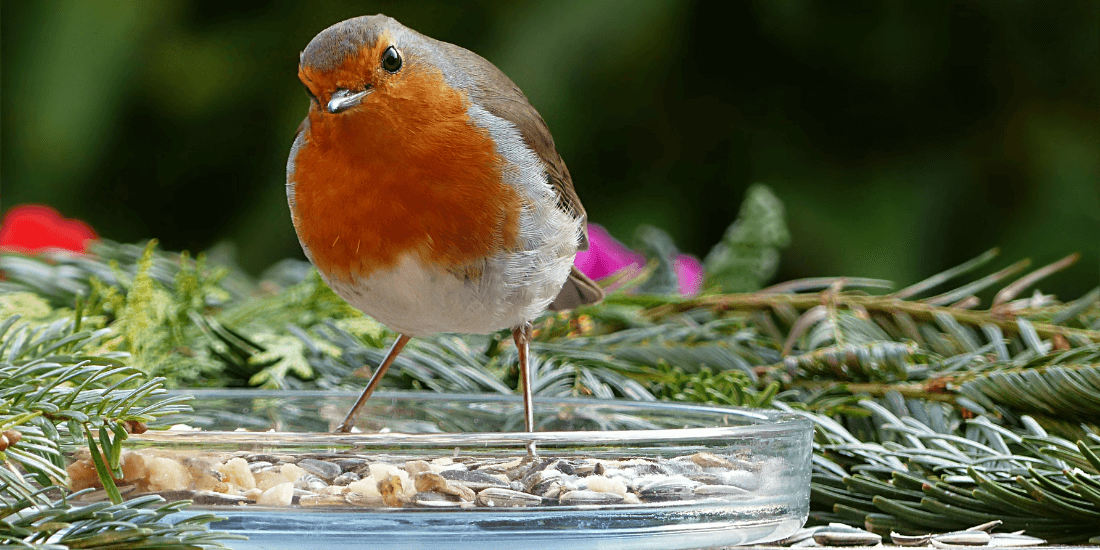How to feed robins in the garden

Robins are a beautiful UK native bird and when they glide into view, their appearance pleases everyone. They are a cute sight in any garden, coming close to humans while they scout for something to eat. What exactly are they looking for and what should you be feeding robins?
What to feed robins?
Robins love insects – primarily, they feast on beetles and worms. You have probably seen them bouncing around with a beetle in their beak. Or you may have seen one watching you attentively while you dig in your garden, hoping to pinch a few worms as you dig them up. But have you ever wondered what else they eat or what bird food to put out when you're about to feed robins in the garden? However, robins also enjoy eating bird food seed mixes, nuts, sunflower hearts, suet, fruit, crushed peanuts and even raisins. They also really enjoy mealworms, which are a great addition to their diet.
The best way to feed robins?
Putting food out and waiting to see which birds are encouraged to come feed in your garden is a delight. But not all birds enjoy the same food or are served the same way. So, we wrote this article to help you attract more robin redbreasts to your garden.
Ground Feeding Trays
Since robins are natural ground feeders, ground-feeding trays are the ideal option for them. A quality birdseed mix or a custom mix using straights that include sunflower hearts and mealworms would be perfect. Simply spread the food out on a feeding tray and watch them feast.
Robins love mealworms so much that you can give them an extra treat by soaking the mealworms in water. This gives the robins extra moisture from their food and makes the mealworms easier to digest.
Bird Tables
Like ground feeding trays, only elevated off the ground, bird tables give robins an easy place to eat that’s safer from predators. Simply sprinkle some seeds, wild bird food or mealworms out on the platform for them to munch.
Food can be left on an open bird table for them to enjoy, but be sure to remove it if it gets wet. Wet or damp food is susceptible to mould and bacteria that will make birds sick. Alternatively, a covered bird table will help to keep food dry and protect smaller birds from predators. But it’s still important you check the food frequently to ensure it’s still safe for them to eat.
Hanging Feeders
Most wild garden birds in the UK enjoy hanging bird feeders. Birds such as bluetits, house sparrows and goldfinches will spend hours tucking into the food they have on offer. Serving up food with a hanging feeder is as easy as filling it up with nuts and seeds, hanging it up high, and watching birds flock to your garden to feast.
Robins are unlikely to use a hanging bird feeder (or hanging tray) unless there is a platform next to it – even then, it’s not their preferred feeding method.
Additional tips to help feed robins:
- Always set aside some time to ensure there is fresh water in your garden for birds to drink and bathe in.
- Put quality bird food out throughout the year; they appreciate it in spring and summer for raising their young, giving them extra energy and warmth in winter.
- Be sure to never put milk out for garden birds as it can make them very sick.
- Avoid leaving them out bread – it does fill their bellies, but it’s not beneficial in terms of nutrients or energy.
- Keep your feeders and feeding tables clean, and regularly check the food for signs of mould or rot
Feeding robins in your garden
Robins, like other wild birds, are more likely to spend time in your garden if they feel safe from predators (like cats). You should place bird feeders around 2 metres away from dense vegetation to boost their confidence and ensure their safety. This will reduce the chances of a surprise attack by cats and means that birds can escape easily if they feel threatened.
Likewise, if you want to give them a place to call home, then nest boxes should be placed in a quiet area of your garden out of the reach of cats.
You can read our post on what do birds eat for more information on this. We also have a blog post that goes into detail on the best ways to store your wild bird food.